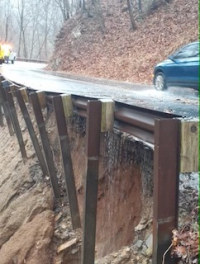The mystical allure of moving water
We are attracted to water. Mountain paths always wind down to water. Water is the essence of our very being ... especially here in the mountains.
Every reader of The Yearling by Marjorie Kinnan Rawlings recalls the novel’s opening wherein the boy Jody makes his way down to the spring below his family’s cabin:
“He stood his hoe against the split-rail fence. He walked down the cornfield until he was out of sight of the cabin ... The east bank of the road shelved suddenly. It dropped below him twenty feet to a spring. The bank was dense with magnolia and loblolly bay, sweet gum and gray-barked ash. He went down to the spring in the cool darkness of their shadows. A sharp pleasure came over him. This was a secret and lovely place ... Beyond the bank, the parent spring bubbled up at a higher level, cut itself a channel through white limestone and began to run rapidly downhill to make a creek. The creek joined Lake George, Lake George was part of the St. John’s River, the great river flowed northward into the sea. It excited Jody to watch the beginning of the ocean. There were other beginnings, but this was his own.”
Jody’s spring, creek, and river were in Florida, of course. Here in the mountains the waterways we call creeks and rivers are more varied and turbulent. But our attraction to them has always been about the same as Jody’s. Running water is more than a material force ... it is a spiritual element.
The old-time mountaineers more often than not picked home sites according to the location and purity of springs. They were connoisseurs of water. Asheville writer Wilma Dykeman records in her fine book The French Broad (Holt, Rinehart & Winston, 1955) that, “When the buyers for the Great Smoky Park were appraising some of the small land holdings one old fellow would come down from his little farm each day.
Related Items
“When’ll you be a-getting to my place,” he’d demand of the buyers.
“We’ll be up there as soon as we can,” they’d reply.
“Well, I’m just aiming to make sure you see my spring,” he said. “You’d have to see it a-fore you could know the worth of my place.”
Once a family’s prize spring was located, the women would sometimes line its sides and bottom with shards of quartz and other sparkling stones. Catching a shaft of light through an overhanging hemlock, the spring would glow in the dim light. It was a place of enduring sustenance and beauty.
Long before the first Europeans arrived, the Cherokee had developed ceremonials focused on the spiritual power of running water. When James Mooney arrived on the Qualla Boundary in the late 1880s, those beliefs were still in place. In a little-known article published in “The Journal of American Folk-Lore” in 1900 (the same year in which his classic volume Myths of the Cherokee first appeared), Mooney described “The Cherokee River Cult:”
“From the beginning of knowledge, Fire and Water, twin deities of the primitive pantheon, have occupied the fullest measure of man’s religious thought, holding easy precedence over all other deities.
“Others were gods of occasion, but these twain were the gods of very existence ... As the reverence for fire found its highest and most beautiful expression in sun worship, so the veneration for water developed into a cult of streams and springs.
“In Cherokee ritual, the river is the Long Man (Yu-nwi Gunahita), a giant with his head in the foothills of the mountains and his foot far down in the lowland, pressing always, resistless and without stop, to a certain goal, and speaking ever in murmurs which only the priest may interpret ... Purification in the running stream is a part of every tribal function, for which reason the town-house, in the old days, was always erected close to the river bank.”
And that tradition is still very much alive. Appalachian naturalist and historian Chris Bolgiano — author of The Appalachian Forest: A Search for Roots and Renewal (Stackpole Books, 1999) — recently asked the Cherokee traditionalist Freeman Owle, “What is the most distinguishing characteristic of your people, the Eastern Band of Cherokees?” Owle may never have been asked this question before, but “after a moment of musing,” he replied: “Going to water.”
Rather than “Going to water” in the formal sense that Owle implies, you and I are more likely to simply amble down to the nearest spring or to a familiar creek or river bank for what we call “a little peace and quiet.” We may or may not take a sip or plunge into the numbing water, yet our attitude toward and use of this most basic of our natural resources is, in essence, no less spiritual than that of the Cherokees. Like them or the early white settlers here in the mountains or country boys like Jody, we have the opportunity to come away after each visit with new beginnings ... but for only so long as we allow these upland waters to flow freely and cleanly.
Editor’s note: This Back Then column first appeared in a June 2002 issue of The Smoky Mountain News.









